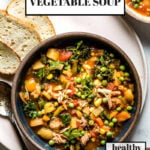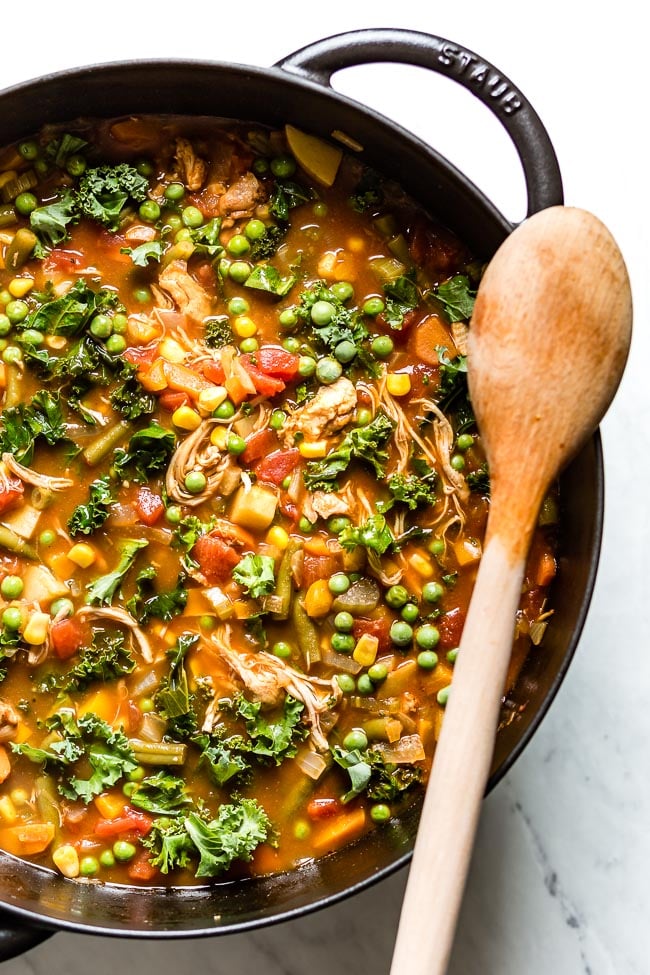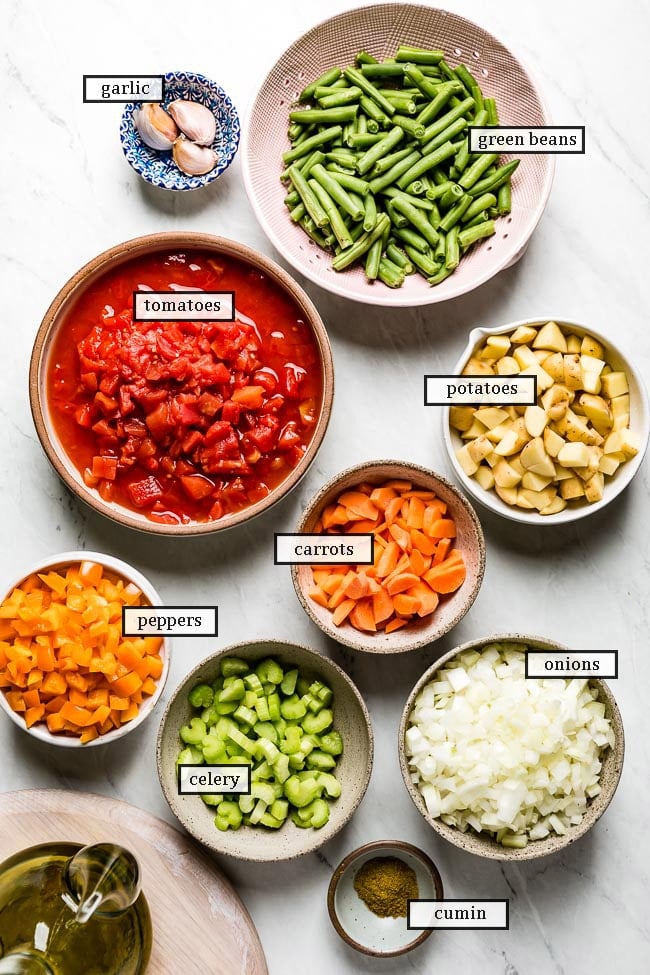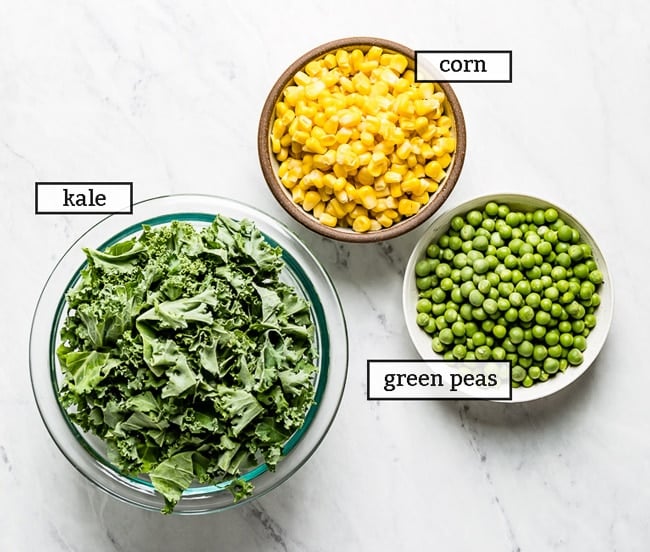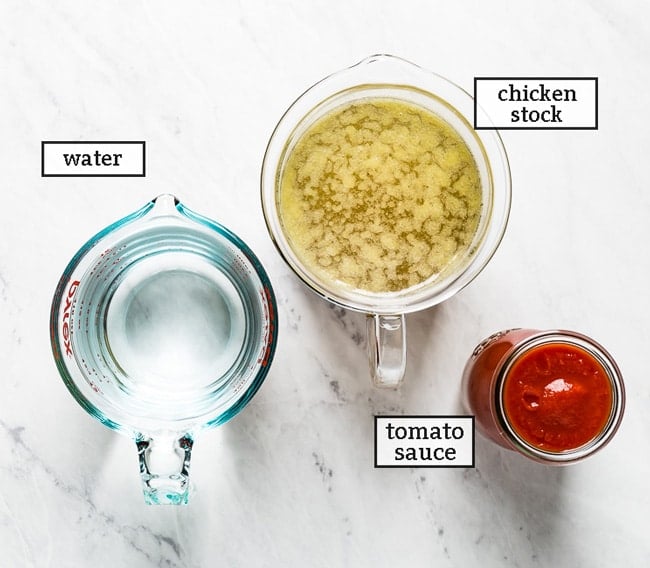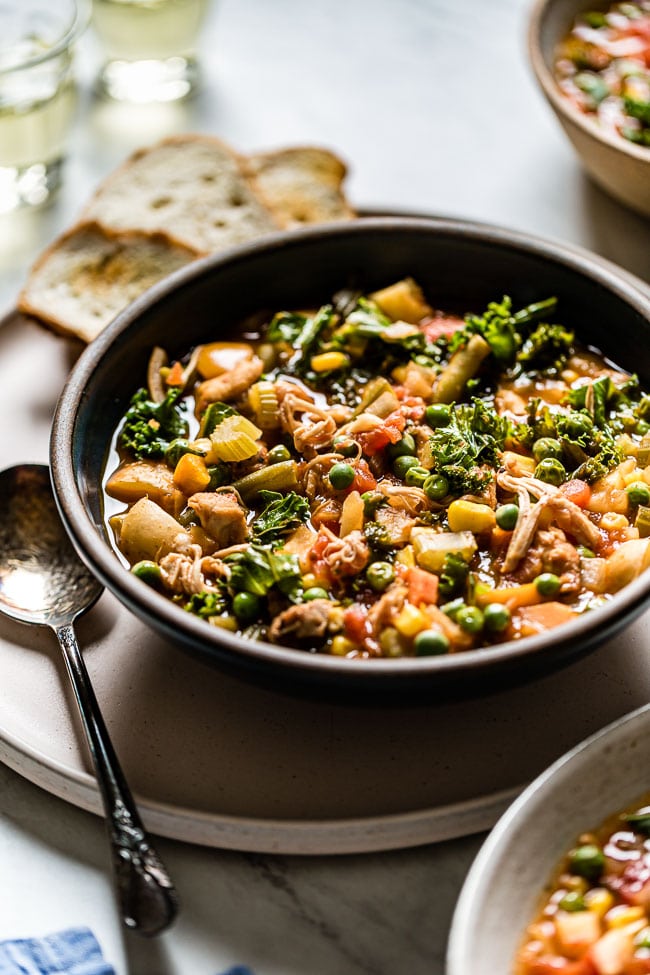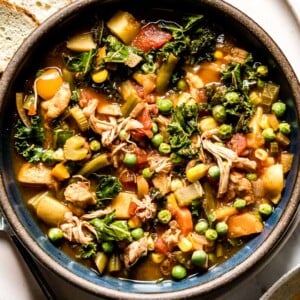So, this year it was a no-brainer to make a similar version with chicken. I mean, I think we can all agree that there are few things more comforting in this world than a bowl of hot, hearty, and homemade chicken vegetable soup from scratch. Packed with all of your favorite veggies and homemade, stick-to-your-bones chicken broth, this vegetable chicken soup just warms you from the inside out, fills you up, and makes your home smell divine. The soup itself is built on a base of homemade chicken stock, which takes this recipe to a new level. However, you can use your favorite store-bought chicken stock as well. In addition to tasting delicious, this gluten-free and dairy-free chicken broth soup with veggies is good for you. Make a big batch, serve some and freeze the rest for later. If you agree, let’s break it down.
Ingredients
If you look at the chicken and veggie soup recipe written below, you might think there are a lot of ingredients. However, don’t let that stop you because this soup is endlessly customizable with easy substitutions, which I will talk more about below. Meanwhile, here is a breakdown of ingredients in 3 categories:
Chicken – What Kind of Chicken To Use?
In terms of chicken, I used boneless, skinless chicken thighs. I like to use thighs because they yield so much chicken flavor that’s perfect for a soup like this, but if you prefer leaner, white meat, skinless chicken breasts will work too.
Vegetables – What Vegetables Do You Put in Chicken Soup?
If you’re asking yourself, “What veggies are good in chicken soup?” I have a simple answer for you, nearly every vegetable! More than anything, I think you will agree that making this chicken vegetable soup recipe is a great way to clean out your produce drawer and use whatever’s in season. Since we are in the middle of winter, I used hearty veggies like onions, carrots, garlic, celery, bell pepper, diced tomatoes, Yukon gold potatoes, and fresh green beans. In the end, I also added fast-cooking veggies like corn, kale, and frozen blanched peas to make it even more veggie-packed.
What other vegetables can I use?
The beauty of this chicken soup with mixed vegetables comes from the fact that you can easily swap ingredients. Don’t have kale; use spinach. No green beans; use broccoli or cauliflower. For example, if you want to introduce seasonal flavors, parsnips, butternut squash, or sweet potatoes would be great additions in the fall.
The Liquid
In terms of liquid, I used a combination of chicken broth, water, and tomato sauce. When it comes to broth-based soups like this, I prefer using a combination of water, tomato and broth, mainly because I make my own broth. However, you can use all chicken broth and omit water as well.
Seasoning Ideas
What sets my recipe apart from other more basic chicken and vegetable soup recipes is that I got some help from everyday spices.
Seasoning for the chicken:
I used a combination of paprika, salt, and pepper to flavor the chicken, which helps build a baseline of flavor before sauteeing the veggies and ensures the chicken is flavorful all on its own. If you are into smoky flavors, you can also use smoked paprika to make this vegetable chicken recipe.
Spices to add to the soup:
For the soup, I seasoned the veggies with some ground cumin. It pairs well with the paprika used on the meat and gives the soup a warm flavor that works beautifully with the vegetables and stock. Suppose you have it and love the taste; you can also add in a tablespoon of Italian seasoning, which is basically a combination of oregano, basil, thyme, rosemary, parsley garlic powder. With that being said, you can use fresh herbs as well.
How Do You Know When To Add Potatoes?
To ensure your cubed potatoes are cooked through, add them early on in the soup-making process when you add the rest of your veggies (except the peas, corn, and kale). They are the starchiest vegetable and will require the most cooking time. Once they’re fork-tender, they’re done!
What To Serve It With?
A Loaf of Crusty Bread (Or French Baguette): If you have the time, I highly recommend baking your own crusty bread like my No-Knead Bread. There’s nothing better than dunking a chunk of homemade bread into homemade soup! Savory Cornbread Muffins: These are so good that I typically keep a batch of them in the freezer during the winter months to serve with soups and chilis. Flavored with scallions and cheddar cheese, these go well with anything, but especially brothy dishes! A Simple Salad: If you want an extra serving of veggies with your soup, a simple salad like my Spring Mix Salad, Brussels Sprout Kale Salad or my Fall Harvest Salad would be delicious! Wild Rice: While wild rice is delicious all on its own, it also works wonderfully with soups, especially chicken soups. Its nutty, earthy flavors would pair well with the veggies in this chicken tomato soup, as well as the cumin and paprika. Just cook it ahead of time, portion it into bowls, and ladle the hot soup on top. And if you need help, check out my foolproof guide to how to cook wild rice on the stovetop and Instant Pot Wild rice recipe. Your Favorite Crackers: Oyster crackers, Saltines, or even tortilla chips would be a delicious, salty, crispy treat to enjoy with this soup.
Variations:
I love this hearty chicken vegetable soup recipe because it’s completely adaptable to fit your taste buds and what you’re craving. Here are some ideas on variations to try:
Stewed Chicken In Crock Pot: If you prefer this soup to have more of a thick chicken stew consistency, try our slow cooker version. Chicken Vegetable Noodle Soup: If you want to change it up, use your favorite pasta instead of potatoes. Simply add them to the cooking liquid in the last 10 minutes and cook it to your liking. Low-Calorie Chicken Soup: If you want to make it low-calorie, feel free to use chicken breasts instead. Chicken Soup with Frozen Vegetables: While I prefer to use fresh vegetables that are in season (except for frozen peas), for the best texture and flavor, if it’s more convenient to use all frozen veggies, go for it! If you decide to go the frozen vegetable route, omit the fresh carrots, green beans, and frozen peas and just purchase a 24-oz bag of frozen mixed vegetables instead and add them during the last 30 minutes of cooking to avoid overcooking them. Quick Chicken Vegetable Soup Recipe: If you are short on time, you can use leftover or rotisserie chicken. Doing so allows you to skip the sauteeing step and save at least 15 minutes. Spicy Chicken Vegetable Soup: If you’re a fan of heat and spice, consider adding some diced jalapenos, red pepper flakes, and/or cayenne pepper to this soup. Great for opening your sinuses!
How To Store, Freeze & Reheat
This chicken tomato vegetable soup can be frozen for up to 3 months. Allow the soup to cool completely and come to room temperature before freezing, then follow these steps:
To Store: Ladle leftover soup into an airtight container or plastic bag and keep in the fridge for up to three days. To Freeze: Ladle cooled soup into individual airtight, freezer-safe containers or plastic bags, and freeze for up to three months. Pop one out of the freezer to defrost in the fridge overnight. To Reheat: Allow frozen soup to thaw in the fridge overnight before reheating. Then, place chilled soup in a saucepan over medium-low heat until just boiling and warmed through. The goal is to warm, not cook again. Ladle into bowls and enjoy!
Other Healthy Chicken Soup Recipes You Might Like
If you are a fan of homemade chicken vegetable soup recipes from scratch, you might also like the ones below that I think are perfect for cold winter evenings: This Recipe is:
Lightened-up Creamy Chicken and Wild Rice Soup Crockpot Chicken Tomatillo Soup One Pot Chicken Fricassee White Chicken Chili Chicken Potato “Noodle” Soup Stuffed Cabbage Soup (This calls for beef, but you could easily swap for ground chicken or turkey if you prefer poultry to red meat.)
If you try this Vegetable Chicken Soup recipe or any other recipe on Foolproof Living, please take a minute to rate the recipe and leave a comment below. It is a great help to others who are thinking of making the recipe. And if you took some pictures, be sure to share them on Instagram using #foolproofeats so I can share them on my stories.

